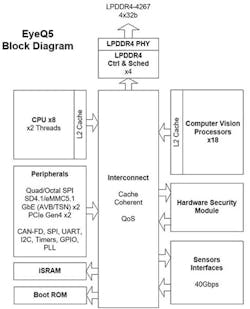Mobileye CEO Explains Camera-Centric Approach to Self-Driving Cars
Mobileye’s camera setup can be found on vehicles supplied by BMW and Volkswagen, among others. It consists of 12 cameras: three cameras in front of the vehicle, two corner cameras facing forward, two corner cameras facing rear, a rear camera, and four parking view cameras. “There are no other sensors in the car,” said Mobileye CEO and Intel Senior VP Amnon Shashua. “Just those cameras. No fancy GPS. Nothing. Only this.”
Mobileye CEO and Intel Senior VP Amnon Shashua. (Source: Intel)
Mobileye’s EyeQ4 chip was launched in 2018 for production vehicles. Its successor, EyeQ5 was sampled a few weeks ago. According to Shashua, version 5 of the system-on-chip (SoC) is about 10 times more powerful than an EyeQ4, runs on a 7-nm process, and performs 24 tera-operations per second for deep learning. He further stated the company already has eight million units worth of orders for EyeQ5.
Designed to support third-party programmability, full-scale production of EyeQ5 will start in 2021 with a number of customers. “The one that we mentioned in the past is BMW, but we have several more,“ he said.
EyeQ5 is based on multiple CPUs and multiple accelerator cores. Shashua pointed out that this was Mobileye’s first silicon that’s not only relevant for autonomous driving, but also is designed in a way that’s applicable to driving-assist (ADAS) implementations. For example, he said “In those eight million units that I mentioned before, the EyeQ5 is on the windshield. None of our competitors, when they talk about their behemoth chips, they don't even imagine that something like this can sit on a windshield. EyeQ5 sits on a windshield.”
Shown is a block diagram of the EyeQ5 SoC. (Source: Intel)
Intel’s Mobileye and Volkswagen AG plan to have hundreds of autonomous taxis on Tel Aviv’s streets by 2022, according to Shashua. These robotaxis will be level-4 autonomous cars, meaning driverless cars that operate only under acceptable weather conditions. He also said that a supportive regulatory environment was being established by the Israeli government, and characterized the U.S. as “under-regulated” with regard to self-driving services.



